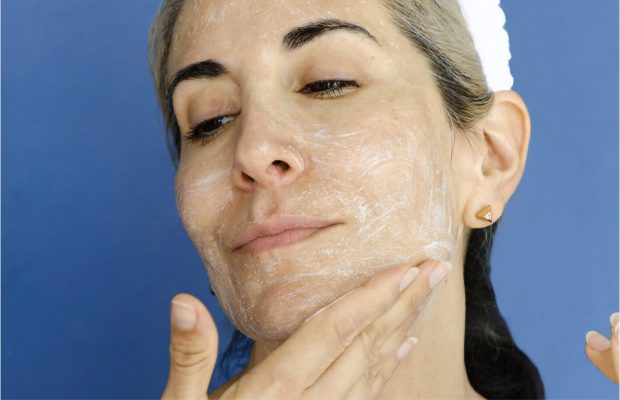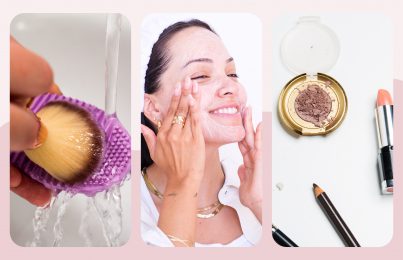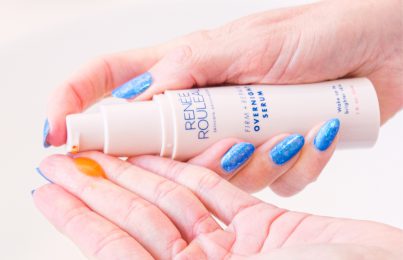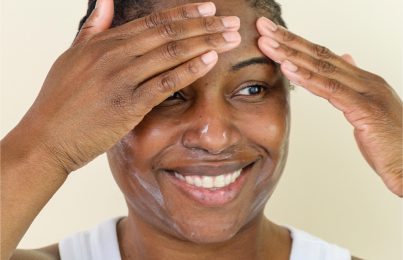Following the correct morning skincare routine order of application, along with choosing the right products formulated for your skin type and using them correctly, is key to getting the most out of your AM skin care regimen. Doing these three things every morning will give your skin maximum benefit throughout the day as it’s subjected to UV rays, pollution, and environmental stressors.
In this post, you’ll learn the exact order you should be applying your products for the perfect morning skin routine. I’ve also included some helpful tips and answers to FAQs to clear up any confusion you might have. Let’s go!
Guidelines to Achieve the Best Morning Skincare Routine
Should My Morning and Night Routines Differ?
Yes, your morning routine should be slightly different from your nighttime skincare routine. That’s because your skin has different needs at different times of day. Morning is all about protecting your skin during the daytime, while your nighttime skincare routine is all about repair.
Should I Put On Sunscreen in the Morning?
Again, the answer is yes! UV protection should be your main focus during your AM skincare routine to protect your skin as much as possible throughout the daylight hours.
How Fast Should I Apply My Skincare Routine?
You should try to perform your routine rather quickly. In fact, you only have a one-minute window after cleansing to apply your next product, also known as the “Golden Minute Rule.” Otherwise, you risk something called transepidermal water loss.
Should I Use Face Oils in the Morning?
Avoid using face oils in the morning. They can dissolve sunscreen, making it less protective.
Make Sure You’re Listening To Your Skin Type
As I said before, it’s so important to choose products formulated for your specific skin type! If you don’t know your skin type, take the Skin Type Quiz to find out.
How Your Skin Functions in the Morning
- Skin cells have the highest water content during this time of the day.
- Natural antioxidant protection is increased.
- The skin’s natural barrier function improves to defend against environmental stressors.
- Improved skin barrier function means products are less likely to penetrate than they are at night.
- The amount of mitochondrial energy needed for cell health is at its lowest.
- The rate of cell growth and production is decreased.
- DNA protection is increased.
The Correct Morning Skincare Routine Order To Apply Products
Step 1: Cleanser
Cleansing is a key step for the performance of your daytime products. You never want to skip this step. Learn why cleansing your skin in the morning is so important.
I recommend using a gentle, sulfate-free foaming cleanser in the morning. They contain surfactants that can cut through oil without leaving the skin feeling tight or dry. Personally, I use and recommend the Renée Rouleau Mint Renewal Cleanser. I formulated it with peppermint oil and jojoba beads to instantly polish and refresh the skin.
Once you’ve finished cleansing your skin, immediately go to the next step in your routine. Remember, you want to work fast!
Step 2: Toner
Toners are misunderstood, but they are very important to use and serve many purposes for the skin. They offer instant hydration, remove chlorine and other minerals found in tap water from your skin, and balance your skin’s pH. They also have active ingredients that help calm the skin, control oil production, support your moisture barrier, and more!
Just make sure you’re using an alcohol-free toner, as they’re generally more gentle and hydrating than alcohol-based toners. The latter are often drying and irritating, especially to sensitive skin types.
Apply all over the face using a thin toning cloth to avoid product waste. Leave it damp on the skin and go to the next step.
Step 3: Vitamin C Serum
The next step in your morning regimen should be to use an antioxidant serum, like the Vitamin C&E Treatment. Skin experts agree that using a well-formulated vitamin C serum in conjunction with your sunscreen is the most effective way to protect your skin cells from environmental damage caused by UV light, pollution, and debris. With time, it can also help brighten dullness and dark spots, so it’s a win-win!
All you need to do is apply a dime-sized amount to your entire face and neck. Your skin should still be damp from your toner, so spreadability should be easy. Once you’ve applied it, let the serum absorb for 60 seconds before applying moisturizer.
Step 4: Moisturizer With Sunscreen
Next up? Sunscreen. This is by far the most important part of your morning routine.
Should I Apply a Moisturizer or Face Oil Over or Under Sunscreen?
Most sunscreens double as moisturizers because they contain ingredients that act as emollients, occlusives, and humectants. This is why sunscreen feels like a moisturizer when it’s applied to the skin. Despite this, people tend to think they need to use both a moisturizer AND a sunscreen, separately.
As long as you’re using a sunscreen formula that feels like it’s giving you the right amount of moisture, it can be used as your morning moisturizer. Granted, some formulas pill up and aren’t so compatible with liquid foundation. You just have to find the one that works for you. Once you do, commit to using it every single day, rain or shine.
People go wrong when they apply an additional moisturizer or a face oil either over or under sunscreen. This could very well interfere with it, making it less effective at protecting your skin. In fact, oil can dissolve your sunscreen without you realizing it.
As mentioned above, sunscreen can double as a moisturizer. You just have to find the right one. Think of it as a 2-in-1 product. It’s better that you do this than risk UV exposure, because, trust me, it’s a lot easier and less expensive to prevent lines and wrinkles than it is to get rid of them once they appear.
What Kind of Sunscreen Is Best, Physical or Chemical?
I recommend using sunscreen that contains both physical and chemical blockers. I believe this gives your skin the best of both worlds. (Read more about the difference between chemical and physical sunscreen.)
Step 5: Eye Cream (Optional)
The reason why I say this is optional is that some eye creams use rich oils and feel greasy. This could negatively affect your sunscreen and makeup. That’s why, if you want to use eye cream as part of your morning product stack, I suggest choosing a lightweight formula, like an eye gel. These types of products will wear better throughout the day.
Step 6: Blemish Spot Treatment (Optional)
There is definitely confusion about the order in which to apply a blemish spot treatment in the morning. If you apply it before your sunscreen/moisturizer, even if you let it dry, your moisturizer will re-wet it and break it down. This makes it less effective. Here’s what to do instead…
- Wipe the blemish with a damp cotton swab to remove the skincare products that you just applied.
- Apply the spot treatment and let it dry.
- Lightly pat (don’t rub) a tiny amount of sunscreen back over the affected area.
- Proceed with concealer if you choose. Ideally, your concealer would have sun protection. A mineral-based one is the best.
Step 7: Makeup
People think they should go without makeup to let their skin “breathe,” but I believe makeup should be worn every day. That’s because it plays an important supporting role in a morning skincare routine. Find out more, here.
Frequently Asked Questions
Here are a few FAQs I get asked concerning peoples’ morning skin rituals.
How Do I Reapply Sunscreen Throughout the Day?
You should definitely be reapplying sunscreen throughout the day to ensure your skin stays protected from harmful UV rays. Here are four ways to reapply sunscreen over makeup.
I Have a Prescription Acne Medication. When Would I Apply That?
Consult your doctor to find out when you should apply your prescription medication in your morning skincare routine. It’s worth noting that many of them can be used at night. Again, your main focus during the day should be sun protection.
What’s Your Opinion on Layering Serums?
I recommend rotating serums (using different serums on different nights) vs. layering them. That’s because the skin can only absorb so much, so you might be wasting money if you’re layering multiple serums on top of each other. At a certain point, the serums won’t be able to be absorbed to deliver their full potential.
What About My Nighttime Skincare Routine Order?
If you’re wondering about the order you should be applying products during your nighttime skincare routine, I’ve also written a blog post about that.
There you have it. Performing your skincare routine is a great way to get your day started, but it’s important that you do it right to ensure you get the very best results!
Celebrity Esthetician & Skincare Expert
As an esthetician trained in cosmetic chemistry, Renée Rouleau has spent 35 years researching skin, educating her audience, and building an award-winning line of products. Her hands-on experience as an esthetician and trusted skin care expert has created a real-world solution — products that are formulated for nine different types of skin so your face will get exactly what it needs to look and feel its best. Trusted by celebrities, editors, bloggers, and skincare obsessives around the globe, her vast real-world knowledge and constant research are why Marie Claire calls her “the most passionate skin practitioner we know.”




Comments:
I used the Mattifying gel moisturizer in the morning then apply the sunscreen last , does the moisturizer decreases the effectiveness of the sunscreen? I like using the mattifying moisturizer bc i have oily skin and it keeps the oil at bay but also need a sunscreen. My question is can I use both layering them moisturizer then sunscreen without reducing effectiveness
Thanks
Posted By: Michael |
Since you have oily skin the hydrating ingredients in the Weightless Protection SPF 30 should be enough to be both your moisturizer AND your SPF, no extra steps needed. We suggest Mattifying Solution for only skin type 1 to use in the evening. An ideal skin type 1 morning routine would be AHA/BHA Blemish Control Cleanser, Balancing Skin Tonic, Skin Correcting Serum, Weightless Protection SPF.
Posted By: Renée Rouleau |